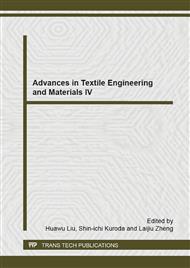p.410
p.414
p.418
p.423
p.427
p.432
p.436
p.440
p.444
Preparation and Characterization of Thermochromic Phase Change Nanofibers/ Woven Composite Material
Abstract:
In order to get a stable heat preserved property of temperature control textile, the sandwich structure of thermochromic phase change nanofibers/ woven composite materials was made by electrospinning, weaving and simple suture. In this material, the thermochromic powder acted as a temperature indicator, lauric acid is selected as phase change material. The morphologies and heat preserved property were characterized by SEM, a digital single lens camera and an increase-decreased temperature system test, respectively. The results showed that such composite materials exhibited an obviously heat preserved property; it took 17mins to decrease the temperature from 50 °C to 30 °C, which was 4 mins longer than the weaves.
Info:
Periodical:
Pages:
427-431
Citation:
Online since:
October 2014
Authors:
Price:
Сopyright:
© 2014 Trans Tech Publications Ltd. All Rights Reserved
Share:
Citation:


